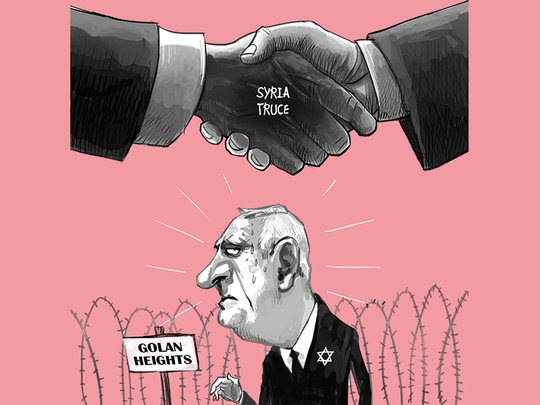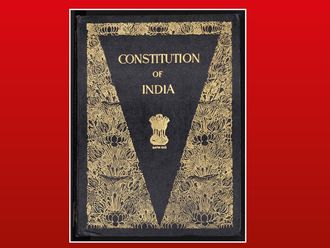
The trilateral ceasefire deal reached between the United States, Russia and Jordan over southwestern Syria, which went into effect on July 7, seems to be holding. Even though the deal had excluded Jabhat Fatah Al Sham (formerly Al Nusra Front) and Daesh (the self-proclaimed Islamic State of Iraq and the Levant) from the truce, there were no reports of clashes. Negotiations between the three interlocutors are said to be continuing in Amman to designate parts of southern Syria as a safe zone and to agree on a permanent monitoring system. According to reports Russia has deployed about 400 soldiers in northern Daraa to monitor the ceasefire.
Iran and Hezbollah have signalled that they were not bound by any agreement in southern Syria. And surprisingly, Israeli reaction to the deal has been negative with Prime Minister Benjamin Netanyahu telling reporters in Paris last week that he opposed the agreement because it perpetuates Iranian presence in Syria. Moreover, Israel has reportedly informed the US of its objection to Russian troops policing safe zones in southern Syria. Both Washington and Moscow have assured Israel that its security concerns will be taken into consideration.
Southwestern Syria represents a strategic border triangle for Israel, Jordan and the Damascus regime. Iran and Hezbollah have been trying to beef up their presence in that area; something that Amman and Tel Aviv staunchly reject. The trilateral deal is said to specify that both the US and Russia will work together to prevent Iran and Hezbollah from establishing a foothold in that area. In return, the regime will be allowed to extend its control over the Nasib border crossing with Jordan, while moderate rebel forces will coordinate military efforts with the Syrian army to oust terrorist groups and engage in local tribal reconciliations.
In an attempt to put pressure on rebel groups, the administration of US President Donald Trump announced last week that it was suspending the CIA programme to train and arm Syrian rebels. This was seen as an important concession by Washington to the Russians. It also signalled a marked change in US position from the Syrian uprising and the fate of President Bashar Al Assad.
Israel’s fears may be genuine. While the US and Russia are likely to succeed in pushing Iran-backed militias from southwestern Syria, it will be difficult to prevent Iran from setting up its own bases in other parts of Syria with Damascus’ consent. The Syrian opposition is now convinced that the two powers are working out plans to create areas of influence in Syria. Turkish media revealed information that the US has established at least ten military bases in northeastern and eastern Syria. Russia’s reaction was enigmatic; saying that such bases should be set up through agreements with the regime. Moscow has two bases in Syria and is said to be setting up a third in the southern part.
It now appears that the US has accepted as fait accompli the fact that western Syria, the so-called useful Syria extending from Damascus to Latakia, to Homs and Aleppo, is now under Russian-Iranian control. Washington seems interested in creating its own area of influence in northeastern and eastern Syria; mainly to undercut Iranian infiltration from Iraq, limit Turkish territorial control of the border areas with Syria and to provide a haven for its new allies: The Syrian Kurds.
That leaves southern Syria and in particular the southwestern part. This is an area that will test US-Russian collaboration. For Jordan, the creation of a safe zone will pave the way for opening the borders with Syria — a vital economic objective for Amman — and for the repatriation of Syrian refugees. It will act as a buffer zone against approaching Iranian militias as well as fleeing Daesh fighters. For Israel, while the Iranians will be prevented from reaching the Golan Heights, the same cannot be said about Hezbollah fighters.
Israel believes that it cannot hand over its security to third parties, even if the US is involved. Russian and Iranian agendas in Syria may be in conflict, but Moscow’s assurances to Israel cannot be taken at their face value. The question is how will Israel react if it believes its red lines in the Golan Heights and southern Syria are being breached? Keeping Iran and Hezbollah few hundred kilometres away in the southeast may not satisfy Israeli concerns.
Israel has in the past taken things into its own hands. It had struck suspected Hezbollah targets and convoys in the Syrian part of the Golan and near Damascus. In 2015, Israeli raids killed two senior Hezbollah members; Jihad Mughniyeh and Samir Kuntar. There is no doubt that the controversial Hezbollah presence in Syria will not end anytime soon.
So while the US and Russia appear to be coordinating a long-term arrangement in Syria that stops short of uniting the country or launching a genuine political transition, regional players are trying to adapt to the new reality. Israel will be watching nervously and it may embark on a unilateral action that could tumble the truce in southern Syria. Ironically, the two bitter enemies, Iran and Israel, feel threatened by the US-Russian entente.
Osama Al Sharif is a journalist and political commentator based in Amman.








